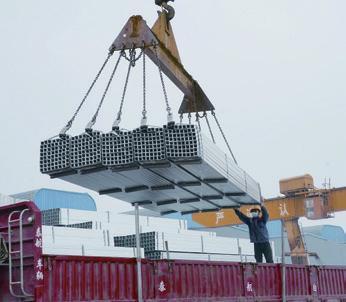Dual-Track Solution
2020-07-13ByZhangShasha
By Zhang Shasha


After a long time, Li Li is going to bed early at night again but she is not happy with the healthy habit. Li is an exporter based in Shenzhen, Guangdong Province in south China, and till recently, would be discussing orders with clients in Europe late at night, given the time differences. However, her mobile phone has been silent these days as the sales have gone down due to the novel coronavirus pandemic.
“We still have some orders to complete but after that, if there are no new ones, we cannot survive for long,” she said ruefully.
Li is not alone in her misery. In the second quarter of this year, global trade in goods would drop by 26.9 percent compared to the first quarter, according to a prediction by the UN Conference on Trade and Development. In China, statistics from the Ministry of Commerce (MOFCOM) showed that foreign trade in goods dropped by 4.9 percent year on year in the first fi ve months, with exports declining by 4.7 percent.
To tide exporters over the difficulties has become a priority for policymakers. Aside from measures to cut costs and taxes, domestic sales have also become an alternative. Since April, many foreign exporters like Li have begun to explore the domestic market. In April, domestic sales of export enterprises increased by 17 percent, according to MOFCOM.
On June 22, the State Council, Chinas cabinet, issued a guideline to bolster this trend by easing market access for exporters exploring the domestic market, expanding their sales channels and strengthening financial assistance for them.
“Export firms are facing predicaments such as increasing logistics costs and lack of sales channels. The policy will help them get new orders to address their extreme urgency in the short run. And in the long run, it will give companies access to two markets and strengthen their competitiveness,” Zhao Ping, Director of the International Trade Research Department at the Academy of China Council for the Promotion of International Trade, told The Economic Observer.
Overcoming hurdles
Chen Yue, who ran a luggage stall in China Commodity City in Yiwu in east China, the largest wholesale market for small commodities in the world, also saw her business turn sluggish. First, the epidemic at home affected her supplies since factories and logistics came to a halt till the situation was brought under control. Then, when Chinas situation began to normalize, her clients, mostly from overseas, grappled with the virus and the orders ceased.Chen thought of selling domestically through e-commerce platforms but realized she would need a professional team, which would cost money. So she chose to switch temporarily to another product: oversleeves worn to protect from the sun. Her clients are domestic retailers and ecommerce buyers.
“Domestic orders, though far less than overseas ones, are immediate deals and the profit margin per deal is higher,” she said, adding that she is trying the new business out for three months to see how it goes.
Wang Xiaosong, a research fellow with the National Academy of Development and Strategy of Renmin University of China, explained the dilemma of exporters. Foreign trade is definitely hard as it costs companies more to research the global market, build trade ties, and organize aftersales services. However, many Chinese foreign traders are contract manufacturers who produce only according to their bulk orders. So domestic sales seem harder to them as the orders are few and not in bulk.
Wang suggests multiple measures for them. To do well in the domestic market, they have to improve their sensitivity to it. The market demand may be different. Products welcomed by foreign customers may not be needed by domestic buyers. And even if the same product is sold in different markets, it needs to be changed in some degrees. So they have to develop new products and build brands instead of focusing just on production.
Since foreign traders are unfamiliar with the rules of market access, sales and payment at home, its hard for them to fi nd sales channels in the domestic market. Besides, some export products may be under intellectual property right protection and may need fresh authorization before they enter the domestic market.
Policy bailout
This is where the June 22 guideline came in. Pang Chaoran, deputy researcher with the Chinese Academy of International Trade and Economic Cooperation, told Economic Daily that the 10 measures in the guideline focus on promoting compatibility between the rules and standards of domestic and foreign markets, smoothing the process between production and sales and enhancing financial support for these fi rms.According to the guideline, products originally made for export will be allowed in the domestic market if they meet certain technical standards. The procedure for compulsory certification of the products will be simplified. Companies are encouraged to make products for export and domestic sales using the same production line and maintaining the same standards and quality to reduce production costs and facilitate the trade transformation.
New domestic sales platforms will be established for these fi rms, such as export product zones at online shopping festivals and promotions in major shopping areas. Suning, an e-commerce giant in China, has already included specific zones for export products on its platforms. In April, over 100 such firms from Guangdong worked with Suning to drum up sales.
Efforts will also be made to connect export firms with the countrys new infrastructure and new urbanization initiatives. They will be assisted to collaborate on inno-vations in the industrial chain, adjust their industrial structure, and accelerate their technological upgrading. Financial institutions have been asked to improve supply chain financing services and strengthen operational credit support for these fi rms.
“Overall, the measures will not only help export companies to tide over but will advance domestic reform and further expand markets both at home and abroad, bolstering foreign trade companies healthy and sustainable development,” Pang said.
A new trend
In the long term, Wang predicts an equal emphasis on both foreign and domestic trade will become a trend for export enterprises. He said such transformation will help contract manufacturers build their own brands. “China already has a strong production capacity. In the future, if companies can expand their strength on the value chain, they can create more value with the same resources based on high-quality products and well-known brands,” he added.It will also help export firms acquire pricing power in foreign trade. Wang said traditional export products do not leave Chinese firms much profit. So, the pandemic period when external demand has declined has become the right time for them to cultivate their brands.
He encourages export firms to make their production fl exible by improving the reaction speed of their production line and supply chain to satisfy small-amount and customized demands. Moreover, they should seize the opportunities in emerging fi elds such as 5G and cloud computing. Traditional industries need to follow the trend in both domestic and foreign markets and harness technology to satisfy changing consumer demand.
Pan Helin, acting Dean of the Digital Economy Institute at Zhongnan University of Economics and Law in Hubei Province, central China, points out that the trend is vital for the transformation of the Chinese economy.
“Encouraging export firms to sell in the domestic market is not only a way to cope with the current international trade situation, but also a must-do measure to stimulate transformation of foreign trade companies. This is also a crucial way to unleash Chinas consumption potential,” he said.

